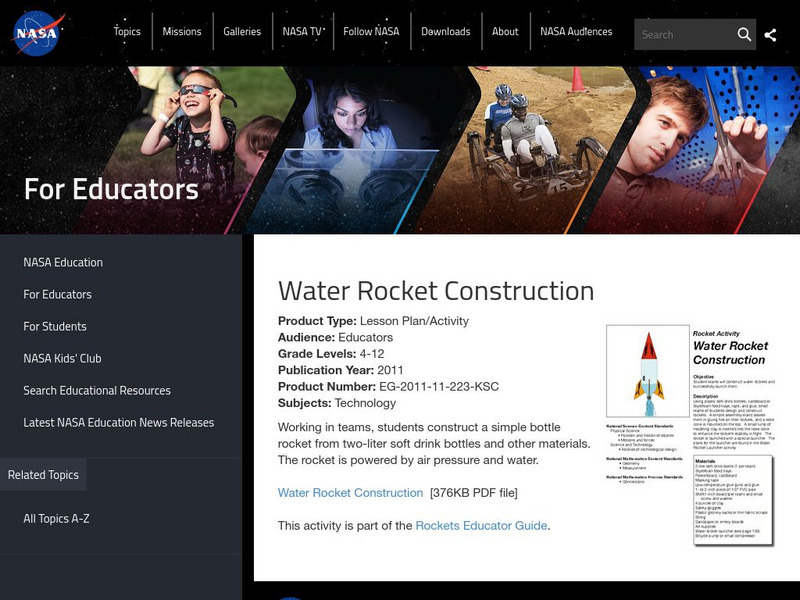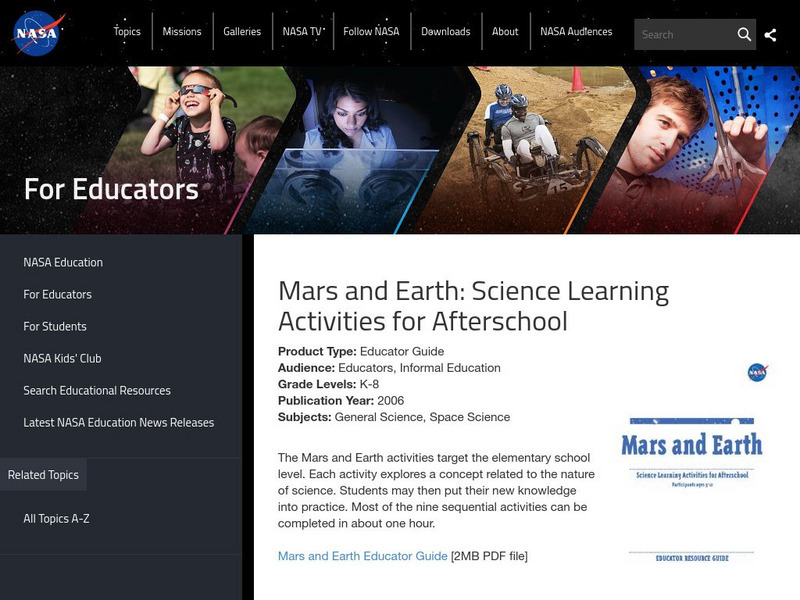Hi, what do you want to do?
NASA
Nasa: Rockets Educator Guide: Water Rocket Construction
Students will follow steps to construct a rocket from a two-liter soft drink bottle and other materials. Students will use the water rocket launcher to launch this rocket.
NASA
Nasa: Diameter of the Moon: Grades 4 12
This lab activity allows students to calculate the diameter of the moon using proportions. Also follow links to other NASA lesson plans.
NASA
Nasa: S'cool: Students' Cloud Observations on Line
S'COOL is a NASA citizen science project where school children gather ground truth measurements that assist in verifying and improving the accuracy of the CERES (Clouds and the Earth's Radiant Energy System) satellite instrument...
NASA
Nasa: White Sands Test Facility
The White Sands Research Facility is a main research and testing area for the Department of Defense, NASA, and commercial industry. White Sands works with rocket propulsion, properties of materials, hazards assessment, oxygen systems,...
NASA
Nasa: Light but Strong
Use these lessons from NASA to teach multiple Next Generation Science Standards for grades K-5. Properties of matter and engineering design are the focus of these lessons. Detailed plans and student handouts are included. [PDF]
NASA
Nasa: Exploring the Moon Educator Guide
This NASA educator guide provides teachers with an outline for teaching a unit about the Moon. Find lessons and hands-on activities about the different parts of the Moon and lunar landing sites.
NASA
Nasa: Climate Kids
Climate Kids thoroughly covers climate change and global warming. There are videos, games, puzzles (e.g., Cloud Picture Scrambles), interactives (e.g., the Climate Time Machine) and stories (e.g., Climate Tales). An educators' page links...
Smithsonian Institution
National Museum of Natural History: Ocean Planet: Water Pollution Toxic Materials
This site, from an archived Smithsonian exhibit, describes and illustrates the effects of toxic materials on wildlife in bodies of water.
NASA
Nasa: Rockets Educator Guide: Heavy Lifting
A lesson plan for students to construct balloon powered rockets. Students will be given the same materials to construct their own rocket and then have a contest to see who can launch the highest paperclip from their rocket.
NASA
Nasa: Rockets Educator Guide: What Comes Next
Learn about NASA's plans for the next 50 years to replace the space shuttle. Discover how the new plan involves two new launch vehicles.
NASA
Nasa: Space Food and Nutrition Educator Guide
The Space Food and Nutrition document, published by NASA, supplies teachers with lessons and activities to introduce students to space food and astronaut nutrition.
NASA
Nasa: Adventures in Rocket Science Educator Guide
This NASA educator's guide provides teachers with an outline for teaching students about rocketry. There are many hands-on activities where students can learn about and build rockets.
NASA
Nasa: Aeronautics Educator Guide
This NASA educator's guide provides teachers with an outline for teaching aeronautics activities. Through hands-on activities, students can learn all about flying.
NASA
Nasa: Packing Up for the Moon Educator Guide
Use these lessons to help students understand more about the preparation it takes to go to the moon. Students will play an active part in decided what to take to the moon when given a specific objective. Includes PDF's (require Adobe...
NASA
Nasa: Mars and Earth: Science Learning Activities for Afterschool
This set of activities teaches students about the big picture of science using Mars as an example: how to collect data, use evidence, and look at models.
NASA
Nasa: Optics: Light, Color, and Their Uses
Download this Educators Guide to light, color, and their uses. Choose from different activities using lenses, prisms, hidden messages, periscopes, and kaleidoscopes
Other
Nasa/msu Bozeman Center for Educational Resources (Ceres) Project
The CERES Project allows the nation's classroom teachers to develop "an extensive library of on-line and interactive K-12 science education materials for teaching astronomy." The site features latest news and photos from NASA,...
NASA
Nasa: Material Analysis
Describes the use of alloys on the space shuttle, and how to analyze alloys using X-ray fluorescence.
PBS
Pbs Learning Media: Why Do We Have Seasons?
Explore what causes seasons on Earth in this interactive adapted from NASA materials that features four cities at different latitudes. Use this resource to view how Earth's axial tilt causes seasons from different perspectives and to...
NASA
Nasa Space Place: Dark Matter
Offers an explanation of dark matter and dark energy, material that scientists cannot directly observe.
NASA
Nasa: Educator Features and Articles
K-12 educational articles, lesson plans, and other teaching materials on current NASA projects that meet national education standards. NASA generates awareness of students' interest in space, science, mathematics, geography, and...
NASA
Nasa: Educator Features and Articles
K-12 educational articles, lesson plans, and other teaching materials on current NASA projects that meet national education standards. NASA generates awareness of students' interest in space, science, mathematics, geography, and...
NASA
Nasa: Earth and Space Science Explorers Poster
This poster of NASA Earth and Space Science Explorers is great for classrooms.
NASA
Nasa: Earth and Space Science Explorers Poster
This poster of NASA Earth and Space Science Explorers is great for classrooms.




















